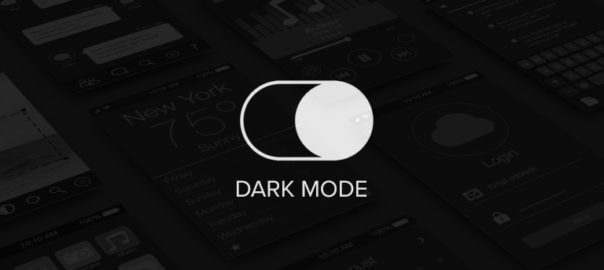The dark theme or the dark mode design has been trending from quite some time now. It became seemingly famous across the world of the internet when Google adopted it for Google drive. It did receive an excellent response from all nooks and corners of the world; however, that doesn’t mean that every business or website can pull off a dark theme. What are the factors that need to be considered before deciding on using dark themes? When should you use dark themes? When should you avoid a dark theme? Let’s check it out.
The Dark Themes Can Be Used When You Want To:
- Emphasize visual content
- Enhance emotional branding
- Go minimalistic
- Match your brand colors
- Improve usability
Emphasize Visual Content
A dark theme is perfect for making visual applications and websites stand out. The deep, substantial backgrounds provide the much needed high-contrast backdrop for images, graphics, videos, and visuals of any shape and color. It elevates the visual hierarchy as the lighter visual content stands out against the dark background; Especially if you’re using large, high-contrast images. If images are playing the lead role in your application, or website, and a copy is a sidekick, consider a dark color palette.
Enhance Emotional Branding
A dark theme needs much more blank space to avoid looking chaotic and cluttered. Thus, dark applications and websites tend to elicit stronger emotions than light ones. Color psychology also impacts the emotional appeal. Generally, we associate dark colors, primarily black, with mystery, power, elegance, and drama. Therefore, when a dark background is paired with some high-contrast, big images, the finished output looks stunning.
This mood-setting strategy works beautifully and frequently appears on product pages and entertainment applications. Apple’s iOS 13 page uses a dark color scheme to make their product seem more sophisticated and elegant. Similarly, the Halo App’s dark theme makes it look more dramatic. However, a lightly-colored website or app can be just as impactful. Choosing the right color scheme depends entirely upon what emotions you want your brand to evoke.
Go Minimalistic With Dark Themes
In case you already use a minimalist design that has limited content, your conditions are suitable for dark mode. In a situation where the text is the primary content, dark UI can make legibility an issue. Typically, dark mode amplifies visual clutter making a cluttered screen even more chaotic.
Match Your Brand Colors
When a brand’s existing color palette is already dark mode compatible, the dark mode is the way to go forward. Think twice about going dark if it seems like you have to change the brand to fit the aesthetic. Similarly, if your brand needs to use a wide spectrum of colors, consider a lighter UI. The full-color spectrum doesn’t read pleasantly on dark backgrounds.
Improve Usability
Sometimes, your app has to be dark to be user-friendly. For instance, apps designed for heavy nighttime use will employ a dark color scheme to avoid straining the user’s eyes. The trend is especially noticeable in entertainment apps like Netflix and Prime Video, but other applications offer a dark mode, too. Twitter lets users toggle between light and dark in the settings, and Google Maps automatically darkens at night.
However, the time of day isn’t the only usability factor to consider. If your application is intended to be used for hours without rest, a dark theme may minimize eye strain. That’s why dark themes are popular in code editors and financial apps.
You must avoid dark themes when your website or app has:
- Lots of text
- Lots of elements
- Bright colors
Lots of Text
One of the most significant drawbacks of a dark color scheme is that it is terrible for displaying text. Light text on a dark background is hard to read. Dark themes are not suitable for interfaces with lots of copy. Not only do people have to spend more time reading the text, but the comprehending ratio also dips. On the other hand, dark text on a white background looks crisp, clean, and refined. The copy is easy to read and extremely legible. Browse across all major news and blogging websites, and you will find that they all have light backgrounds instead of dark ones. Your website should not have a dark theme if it contains lots of written content.
Lots of Elements
Finally, a dark theme can be a poor choice for apps and websites with lots of icons, buttons, and small images. That’s because of the dark background de-accentuate empty space. While de-emphasized empty space makes large images and minimalist pages elegant and dramatic, it makes small icons and dense pages look cluttered, unorganized, and unprofessional. Admin backend panels are a great example. The difference is even more obvious when you compare a light panel with a dark one.
On dashboards, the dark theme does not look bad, but it does look denser. In some instances, that’s not a problem. However, the clutter problems don’t end here, because, with a dark color scheme, it’s hard to make each element stand out. Since a dark color scheme limits your color selection, it’s harder for a designer to maintain good contrast. This does not pose a problem if a page has a few key elements, but if a page contains several buttons, icons, menus, and banners, the overall design will look much less cluttered on a light background.
Bright Colors in Dark Themes
Dark themes also limit your color options. Too many bright colors can clash against the dark background and give your entire website a harsh and unfriendly appearance. While the occasional splash of color can add brilliant emphasis, most of your elements should be muted neutral colors.
Read more about how to use colors in web design here
There are a lot of advantages to using a dark theme:
- It reduces the strain on eyes
- It increases visibility in low-ambient lighting
- Saves a lot of battery life
- Gives an emotional boost
But, you need to understand that one size doesn’t fit all, and hence the pointers mentioned above will help you in deciding if you must use a dark theme or not. Still, confused? Talk to our experts now!



